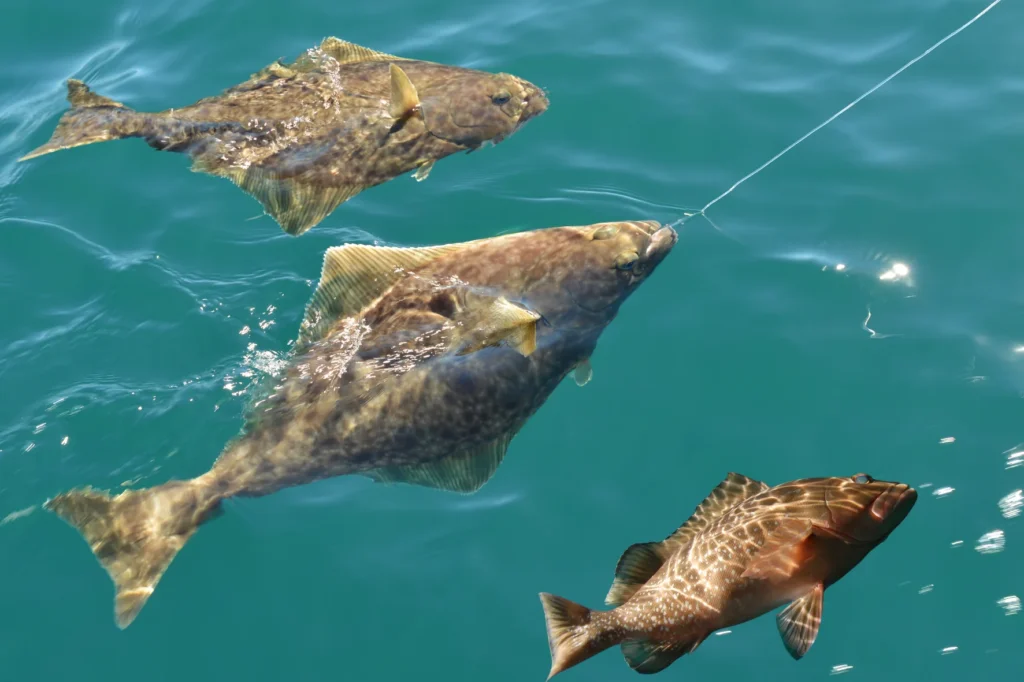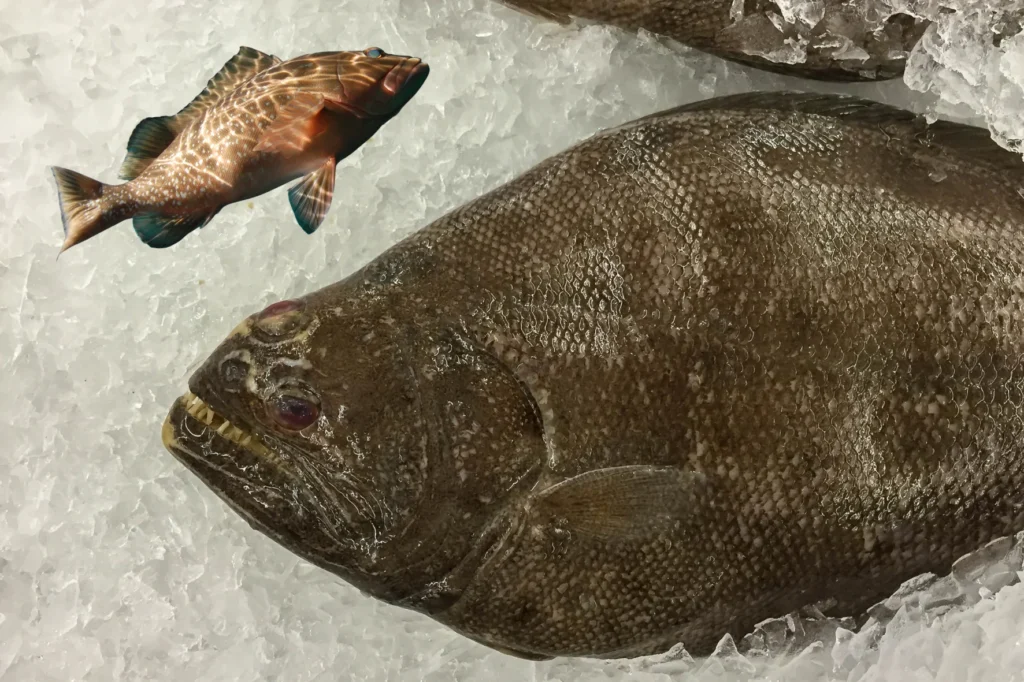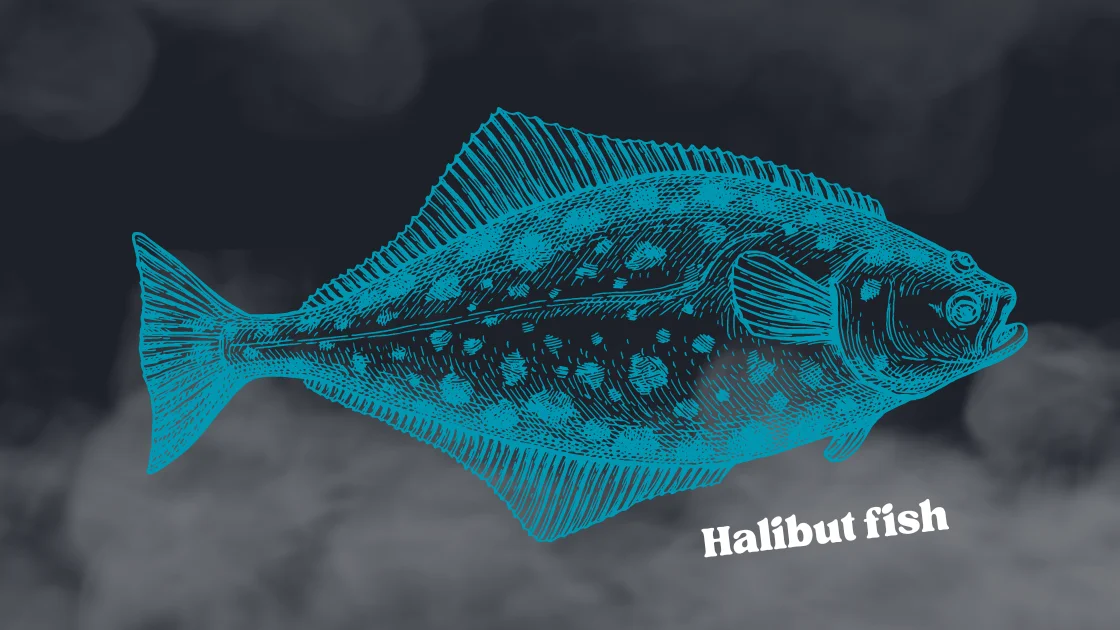Halibut is a prized seafood that has fascinated seafood enthusiasts for centuries. Halibut’s smooth, delicate flavor has made it a favorite among seafood lovers worldwide. This comprehensive guide will take you on a journey into the secrets of this amazing fish, from its anatomy and characteristics to its habitat and fishing methods. So let’s dive into the wonderful world of halibut!
Anatomy and Characteristics
Halibut, scientific name Hippoglossus stenolepis, belongs to the flounder family. They are easily recognized by their distinctive shape with eyes on the sides of their heads. This adaptation allows halibut to lie on the ocean floor and hide from predators and prey. The average size of halibut ranges from 20 to 150 pounds, with rare specimens exceeding 300 pounds.
One of the most interesting characteristics of halibut is its remarkable growth. They begin as tiny larvae that float near the ocean’s surface and undergo a dramatic metamorphosis as they mature. Halibut live long lives, with some individuals living up to 55 years. It is a long-bodied fish with a large body, making it a good place to fish.
Habitats and Fishing Methods
Halibut live in the cold waters of the North Atlantic and North Pacific. They grow in a variety of habitats, including rocky bottoms, sandy areas, and even deep ocean trenches. These fish are known for their migratory behavior, moving to shallower waters in search of food in the summer and returning to deeper, colder waters in the winter.
Halibut fishing is an exciting and rewarding experience. Hunters use different methods to capture this wild animal. A common method is drift fishing, in which fishermen use thin hooks or artificial lures to lure halibut with the current. Another method is bottom fishing, where you drop a weighted fishing line on the ocean floor to catch bottom-dwelling halibut. No matter how you fish, catching halibut requires patience, skill and a little luck.

Health Benefits of Eating
Halibut is not only delicious, but also has many health benefits, making it a great addition to any diet. This fatty fish is an excellent source of high-quality protein, which is essential for building and repairing tissues in the body. It’s also low in saturated fat and cholesterol, making it perfect for those who want to maintain a heart-healthy, balanced diet.
- The Firefish Goby | Secrets of the Colorful Underwater Marvels
- Mastering Black Drum Fishing
- Robalo Fish | Exploring Its Habitat, Behavior & Fishing Methods
- Carp | Exploring the Versatile Fish with a Rich History and Ecological Impact
Halibut is rich in omega-3 fatty acids, which promote brain health and reduce the risk of heart disease. These fatty acids also play an important role in reducing inflammation in the body and supporting overall joint health. In addition, halibut is a good source of essential vitamins and minerals such as vitamin B12, vitamin D, selenium and potassium.
Popular Halibut Recipes and Cooking Techniques
this fish has a mild, delicate flavor, making it a versatile fish that can be prepared in many ways. Whether you grill, bake or braise, there are countless recipes and cooking methods to suit your tastes. Common methods of cooking halibut include:
- Marinated Halibut with Lemon and Herbs: Marinate this fish fillets in a mixture of lemon juice, olive oil, garlic and fresh herbs. Cook the fish on medium heat until the fish is dry and cooked easily.
- Baked Halibut with Parmesan Crust: this fishfillet with breadcrumbs, grated Parmesan cheese and herbs. Bake in the oven until the skin is golden brown and the fish is tender.
- Baked Halibut with Mango Sauce: Season this fisht fillets with salt, pepper and paprika. Heat olive oil in a pan and fry until golden brown on both sides. Serve with spicy chutney for a tangy flavor.
These are just a few delicious halibut recipes. Get creative in the kitchen and explore different flavors and cooking methods to get the most out of this precious saltwater fish.
Tips for Buying and Storing
When shopping for this fish, there are several important factors to consider to ensure you are getting fresh, high-quality fish. Look for halibut that doesn’t smell and has firm, translucent flesh. The skin should be clear and free of blemishes, and the flowers should be bright red or pink. If you are buying an apartment, make sure it has low humidity and light color.
To store this fish properly, it is best to refrigerate it at 4 degrees Celsius (40 degrees Fahrenheit) or less. If you plan to eat the fish within a day or two, chill it on ice to keep it fresh. For long-term storage, we recommend wrapping this tightly in plastic wrap or storing in an airtight container before freezing.
Sustainable Fishing Practices
As responsible consumers, we need to be aware of the sustainability of the fish we eat. this fish stocks have faced challenges in the past due to overfishing, but with effective management and sustainable fishing practices, their numbers are showing signs of recovery. When buying this, look for labels or certifications that indicate the fish has been sustainably sourced or caught in a way that minimizes environmental impact.
Sustainable fishing practices for this include using selective gear to limit catch, enforcing catch and size limits, and implementing seasonal closures to protect spawning grounds. By supporting sustainable fishing, you can ensure the long-term survival of halibut and protect this precious resource for future generations.
Fishing Regulations and Seasons
To maintain this fish populations and maintain sustainable fishing practices, many areas have established fishing regulations and fishing seasons. These regulations vary by location and may include catch limits, size limits, and restrictions on fishing methods. It is important for hunters to be aware of the specific regulations in their area to ensure compliance and aid conservation efforts.
this fishing seasons also vary by region and can change from year to year. We recommend contacting your local government or hunting organization for the most up-to-date information on hunting seasons and temporary closures and restrictions.

Famous Halibut Fishing Destinations
If you’re looking for the ultimate hali fishing experience, many of the world’s most popular spots offer great opportunities to catch this rare fish. Here are some popular hali fishing spots.
- Alaska: Alaska is known for its abundance of hali, making it a prime fishing destination for hali lovers. The waters of the Gulf of Alaska, Cook Inlet and Inlet Passage are known for giant flounder.
- Norway: Norway’s coastal waters are home to halibut and attract fishermen from around the world. The Lofoten Islands and the Barents Sea are particularly famous for their hali fishing opportunities.
- British Columbia, Canada: With its extensive coastline and diverse marine environment, British Columbia is a prime location for halibut fishing. Areas such as Haida Gwaii and the Queen Charlotte Islands are known for their thriving fisheries.
These are just a few examples of the many amazing halibut fishing spots around the world. Each location offers its own charm and fishing experience, giving anglers the opportunity to catch the fish of their dreams.
Conclusion
Halibut, with its mild flavor and impressive size, attracts seafood lovers and fishermen alike. From its unique anatomy and migratory behavior to its health benefits and different cooking techniques, halibut offers a world of culinary possibilities. By supporting sustainable fishing practices and following fishing regulations, we can ensure the longevity of populations and preserve this valuable marine fish for future generations. So, the next time you have a craving for seafood, indulge in the delicious flavors of halibut and uncover the secrets of this remarkable fish.


2 thoughts on “Halibut Fish | Secrets of Saltwater Fish”